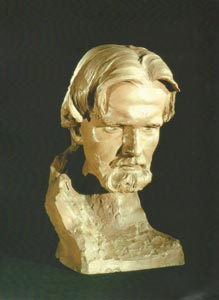
Alfred Laliberté, self-portrait, c. 1918
BIOGRAPHY
Born at Ste. Élizabeth, Arthabaska, Alfred Laliberté was the son of a woodcutter. After studying at the Conseil des arts et manufactures in Montreal, Laliberté travelled to Paris in 1902 to attend the École des beaux-arts and successfully showed sculptures based on Canadian themes at several spring Salons. A public subscription helped finance his study in Europe and one of his greatest supporters was Sir Wilfrid Laurier.
He returned to Canada in 1906 but made visit in France in 1910, 1917 and 1923.
He embarked on several decades’ worth of commissions for sculptures that commemorate Canada’s history and heroes, of which the 1926 Monuments to the Patriots of 1837 in Montreal is among his most celebrated. In 1928, he turned to his rural Quebec roots and executed over 200 small bronze sculptures devoted to the occupations, customs and legends of French Canada. His attachment to the old ways made it difficult for him to accept the pace of modern life. In Mes souvenirs, Laliberté expressed his fear that “machinery is also the reason for the near collapse of art”. He was a professor at the École des beaux-arts. Joseph Franchère, Maurice Cullen, Robert Pilot, Jean Palardy, Jori Smith and Mario Merola all worked under its roof.
A prolific artist, he produced more than 900 sculptures over his career. Some example of his larger works include the satute of “Dollard des Ormeaux”, Lafontaine Park, Montreal, a public fountain at The Parliament Buildings, Quebec City. He wrote his memoirs in four parts: Mémoires, Artistes de mon temps, Les hommes et les choses and Réflexions.
SUBJECT
Laliberté employs mythological figures in his sculptures.
On of his most remarkable undertakings was a series of bronze figures depicting the history of French Canadians.
TECHNIQUE/MEDIUM
His series depicting the history of French Canadians were modelled in clay and then cast in bronze. He also did paintings.
AWARDS
In 1904 at the Salon de Paris and received “special mention” for his ”Jeunes Indiens chassant” (Young Indians hunting) now in the National Gallery of Canada.
He was elected an Associate of the Royal Canadian Academy in 1912 and became a full member in 1919. He also was a member of l’Académie des beaux-arts de l’Institut de France in the sculpture section in 1948.
Source: Anne Newlands, Canadian art from its beginnings to 2000, Firefly, 2000 ; Colin S. Macdonald, A dictionary of Canadian Artists, Volume 3, 1975